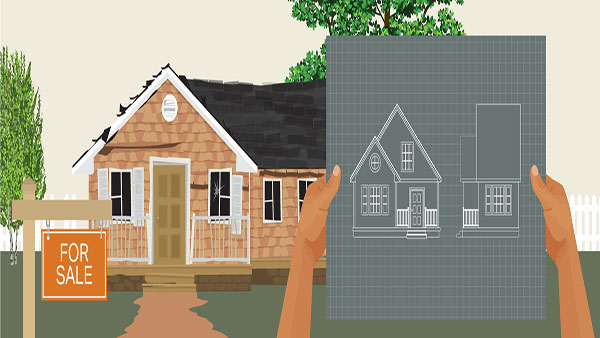By Lee Wallender
Contributing Writer
 House fixer-uppers are more popular than ever. Sparked by economic changes and fueled by the influence of TV home shows and shelter magazines, ordinary folks, not just developers, are purchasing fixer-uppers both for personal use and for profit.
House fixer-uppers are more popular than ever. Sparked by economic changes and fueled by the influence of TV home shows and shelter magazines, ordinary folks, not just developers, are purchasing fixer-uppers both for personal use and for profit.
But the ease with which TV crews transform a shack into a mansion is not at all accurate for someone who wants to do this in real life. After you get honest with yourself about why you’re doing this, you then need to assess whether you’re purchasing the right house and how exactly you intend to remodel it.
Top 5 Reasons to Buy a Fixer-Upper
The reasons that a person may take on a fixer-upper vary greatly. Some people have a purely financial reason for doing this and may care little about home design and construction. At the other end of the spectrum are people who believe that the house will be a manifestation of their creative dreams.
Before anything else, decide why you want to buy a fixer upper. Your answer to this question then becomes the controlling theme that will help so many other decisions fall into place.
- You Want to Flip a House to Make a Profit
House flipping means purchasing a residential property for a low price, performing either cosmetic fixes or light remodeling, and then selling it within a year to make a profit.1
The heyday of house flipping occurred from 2008 to 2012, when many homeowners were having trouble meeting their mortgages. As a result, houses were being foreclosed on in record numbers. This meant that amateur speculators, not just professional property developers, could inexpensively pick up a house, fix it, and sell it quickly for a profit.
Today, house flipping is still a viable prospect. But according to experts, the profit margin is slimmer and available houses are fewer because the foreclosure market has shrunk, and more people have joined the house-flipping game.2
- You Want to Create a Rental Property for Passive Income
Another way to make money with a fixer-upper is a longer-term, slower method: rental. To create an attractive rental property, you purchase a house in need of tender love and care, put money into it either with do-it-yourself fixes or by hiring a contractor, and then rent the property out. Usually, rental leases run for one year at a time. This provides you the assurance of a steady income for a solid year but gives you the flexibility of being able to move the current renters out if you should decide to sell the house.
- You Want a Dream Home for Your Own Use
If you look at that house and can see a diamond in the rough under the dust and spider webs, you are a true romantic, possibly an artist, and definitely a dreamer. Few feelings compare to buying an inexpensive fixer-upper and bringing the house back to its former glory or transforming it into a completely different type of house. This is sheer artistry wrought on a large scale.
- You Want to Fix It, Live in It, Then Sell It
Another reason you may want to buy a fixer-upper is a hybrid reason, part profit and part dream. You purchase a house, fix it up, and live in it for a number of years before selling for a profit. While you may love your remodeled home, you maintain a sense of detachment, knowing that this is a relationship that is only temporary.
- You Want to Bring Family or Friends Together
As our population ages and families want to stay closer together, many people want to live near their relatives. Grandparents benefit from being near younger generations, and parents love having older folks around as a source of convenient, free childcare. Rather than everyone living together, the solution is to have a separate but near residence. This is often accomplished in the form of a fixer-upper that you alone have purchased or one bought in conjunction with family members. You buy an inexpensive house, fix it up to a reasonably comfortable, attractive level, and then move the relatives in. With elderly relatives, this often involves incorporating changes that make the house more accessible.
DO: Match House to Needs
Purchasing the right kind of house to fix depends on one of the reasons you’re doing this in the first place. Example: if you are purchasing the house to fix up and then rent, make sure that it is of rentable quality – in all respects. Is it near traffic arteries and bus lines, schools, shopping districts, and other perks that potential renters find attractive?
If you’re purchasing the fixer-upper for family, remodels should ensure safety and general appearance. But since you are not selling the property, the remodels do not have to be flashy and showroom-worthy; they just have to be attractive and safe.
DO: Be Aware of Different Levels of Fixer-Uppers
Obviously, not all fixer-uppers are in the same condition. And the condition of homes will be viewed differently by different people. Here are five main levels of fixer-upper conditions, from the most severe and expensive down to the easiest and less expensive:
- Tear Down:This property is so far gone that nothing can save it. The only recourse is to tear it down and rebuild. Sometimes the foundation can be reused. Other times, the foundation was the very reason for the tear-down, and thus it too needs to be rebuilt.
- Strip to the Studs and Beyond:Foundation and underlying house frame are in good condition, but its “skin” is not. Skin includes both exterior siding and interior drywall or plaster. After opening up the house, all services – electrical, plumbing, heating, cooling – are removed and replaced.
- Strip to the Studs Only:Exterior siding and interior walls (either one or both) are replaced. Electrical and plumbing services are mostly retained, but changes may be made to bring the house up to date.
- Purely Cosmetic:Structure, services, walls, and siding remain structurally the same. Walls are painted, floors covered, countertops replaced. In bathrooms, toilets may be replaced and shower/tubs replaced, relined, or refinished.
DO: Consult Experts
Experts, both paid and unpaid, are out there waiting to give you advice. Develop a professional relationship with a realtor who can provide you with insider information about local real estate trends. On both the purchasing and selling ends, realtors can be among your greatest allies. Contractors may meet you at a house you intend to purchase, and for an hourly fee (or sometimes free, with the expectation of future work), they can give you a detailed assessment of the home’s state of affairs.
AVOID: Unrealistic Remodel Plans
Remodeling is part and parcel of every fixer-upper purchase. But in practical terms, how will that happen?
Will you hire a contractor who takes on the entire project for you as a full-service turn-key operation where you have very little to do other than make requests? The price you pay can be quite steep, typically including a contractor’s commission in the range of 18% to 25%. Contractor-driven fixer-uppers will get done quickly and professionally, presumably at top quality. But the higher costs will eat into your profit margin if reselling is your aim.
At the opposite end are do-it-yourself remodels that have no contractor’s commission. Doing your own work also allows you to keep a close eye on costs. If you want to flip the house, your profit margin will be as fat as possible. However, do-it-yourself remodels take longer to complete, during which you are paying a mortgage each month. Paying the mortgage on an unused, uninhabited house is money wasted in the event of house flipping. If your plan is to move yourself or relatives into the house, it represents time wasted.
AVOID: Real Estate Blinders
Like the horse with blinders who only sees one direction, potential buyers of fixer-uppers can develop blinders that prevent them from seeing the entire picture. Peripherals that buyers tend to ignore include:
- Area:It is not enough to like the house; you need to like the general area, too. Your area needs shopping outlets, nearby transportation, a low crime rate, and steady or gradually rising property values.
- Neighbors:Adjacent neighbors can make your fixer-upper purchase a pleasure or a living hell. Chat with your potential neighbors before purchasing to see whether you can co-exist with each other.
- Property and Yard:Your new home should have a yard that has landscaping potential or is already landscaped. If the home is in the suburbs, a spacious yard for children may be desired.
AVOID: Hidden Costs That Blow the Budget
Speaking to experts is one way to uncover landmines that may cost you too much money to make the fixer-upper worth it.4
Issues that may arise include huge, untended trees; steeply sloping topography; easements; historical designations that make remodeling difficult; and buried fuel tanks.
Get Real About Money by Budgeting Your Remodel
House Repair and Remodel Estimate Sheet Based on a 1,500-2,000 sq. ft. Living Space Single Family Home
Chimney Repair or Replacement
- Repoint $500
- Rebuild $1,000-$5,000
Roof Repair or Replacement
- Entire Roof: $5,000-$8,000
- Partial Roof: Calculate at $275 to $350 per 100 sq. ft. Section
Exterior Paint or Siding Repair or Replacement
- Paint: Single Family 1500 sq. ft.: $3,000-$5,000
- Entire Siding: $6,000-$8,000
- Partial Siding, Calculate at $275 to $500 per 100 sq. ft. Section
Windows Repair or Replacement
- Number of Windows x $325-$500
- Bay Window: $1,000-$2,000
- Repair $25-$100
Exterior Doors Need Repair or Replacement
- $250-$400 ea.
Garage Repair or Replacement
- 1 Garage Door: $650
- 1 Reframe Structure: $1,500
- 1 Car Interior Paint: $500
- 2 Car Interior Paint: $1000
Driveway Repair or Replacement
- $2,500-$5,000 Average Driveway Replacement ($4-$6/sq. ft.)
Yard Cleaning and Landscaping
- Landscape $300-$5,000
Fence Repair or Replacement
- $100-$150/section
Septic Tank Replacement or Removal
- $5,000-$20,000
HVAC Repair or Replacement
- Replace 1 Furnace: $3,000
- Replace 1 Boiler: $4,000
- Replace 1 Hot Water Heater: $800-$1,200
- Install 1-2 Zone Baseboard Heater Including Boiler: $7,000-$10,000
Plumbing Repair or Replacement
- $1,000-$5,000 Rough Plumbing (Drains, Venting, Water Lines)
Electrical Repair or Replacement
- 1 New Panel: $1,000-$1,500
- Fixtures: $400-$1,000
- 1 New Service, Panel, Rewire House: $5,000-$10,000
Foundation Repair or Replacement
- $50-$150/linear foot
Basement Structure Repair or Replacement
- Pour Concrete Floor: $1-$3/sq. ft. (new), $0.50-$6/sq. ft. (repairs)
- Replace Stairwell: $1000-$2000
Interior Doors Repair or Replacement
- $125-$200 Each
Closet Shelves
- $50-$100 per Closet
Framing Repair or Replacement
- $500-$5,000 Depending on Scope
Interior Trim Repair or Replacement
- $2-$4/linear foot
Interior Paint
- Interior Paint: $2/sq. ft. (living space) as a General Rule
- Single Family: 1500/sq. ft. $2800
Carpeting
- Carpet $2-$4/sq. ft.
Laminate or Vinyl Flooring
- Laminate/Vinyl $3-$6/sq. ft.
Ceramic Tile
- $5 to $10/sq. ft.
Wood Floors Sanded and Refinished
- Hardwood Install at $6 to $10/sq. ft.
- Sand and Refinish at $1.50 to $2/sq. ft.
Kitchen Cabinets Repair or Replacement
- Single Family Cabinets and Counters: $2,500-$6,500
Insulation Replacement
- Attic/Basement: $1-$1.50/sq. ft.
- Wall: $0.50-$1/sq. ft. (coverage area)
Kitchen Appliances
- 1 Stove: $500-$1,000
- 1 Refrigerator: $800-$1,500
- 1 Overhead Microwave: $300-$500
- 1 Dishwasher: $350-$700
Bathroom Fixtures and Accessories
- Shower: $600-$2,000 Install: Add $500
- Toilet: $75-$200 Install: Add $150
- Vanity/Sink: $150-$600
- Mirror/Towel Bar/Toilet Paper Holder/Towel Ring: $100-$300
- Patches: $1-$2/sq. ft
Drywall Repair or Replacement
- Skim Coat Only: $0.50-$1/sq. ft.
- New Greenboard/Plaster/Drywall: $1.10-$1.50/sq. ft.
Dumpster Rental and Demolition
- Dumpsters: $500 ea.
- Demo Labor: $500/filled dumpster
Exterior Decks
- 10×10 = $2,000
- 15×15 = $3,000
Buying a fixer-upper house for either profit or to live in requires planning to make sure that you get a viable property that will not empty out your bank account.
Lee Wallender began remodeling homes when he transformed a World War I-era farmhouse into a comfortable new home. He has been writing about home remodeling on About Home Renovations since 2006.
 Pride News Canada's Leader In African Canadian & Caribbean News, Views & Lifestyle
Pride News Canada's Leader In African Canadian & Caribbean News, Views & Lifestyle






